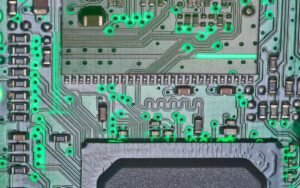How Are AI Models Trained?
Artificial Intelligence (AI) has become an integral part of various industries, from healthcare to finance. But have you ever wondered how AI models are trained? In this article, we will explore the process of training AI models and the techniques involved.
Key Takeaways
- Training AI models involves feeding them with large amounts of data.
- Supervised learning, unsupervised learning, and reinforcement learning are common approaches used in training AI models.
- Deep learning, a subset of machine learning, has gained popularity in training AI models.
**Training AI models typically begins with a large dataset of labeled or unlabeled examples**. These datasets serve as the foundation for training the AI model to learn patterns, make predictions, or solve specific tasks. **During the training process, the AI model adjusts its internal parameters to minimize errors and improve its performance based on the provided data**.
**Supervised learning** is a commonly used approach in training AI models where labeled examples are used to teach the model how to map input data to the desired output. This approach requires a human expert to provide the correct answers for each input, enabling the AI model to learn from those examples and make accurate predictions. *For example, in training an image recognition model, each image is labeled with the corresponding object it represents, such as a cat or a dog*.
**Unsupervised learning** is another approach to training AI models, which involves training without labeled examples. The model learns the underlying patterns and structures within the dataset on its own, seeking to find meaningful representations or clusters. *In unsupervised learning, the AI model explores and discovers hidden patterns without any prior knowledge of the correct answers*.
**Reinforcement learning**, inspired by how humans learn through rewards and penalties, enables an AI model to learn from interactions with an environment. The model receives feedback in the form of rewards or punishments based on its actions, assisting it in learning the optimal behavior to achieve a particular goal. *For instance, in training an AI model to play a game, the model receives a positive reward for winning a level and a negative reward for losing*.
| Training Technique | Description |
|---|---|
| Supervised Learning | Uses labeled examples to teach the model how to map input data to the desired output. |
| Unsupervised Learning | Trains the model to find underlying patterns and structures within the dataset without labeled examples. |
| Reinforcement Learning | Enables the model to learn through interactions with an environment and feedback in the form of rewards or punishments. |
Deep Learning and Neural Networks
**Deep learning**, a subset of machine learning, has become increasingly popular in training AI models due to its ability to handle complex tasks and process large amounts of data. Deep learning involves using **neural networks** – interconnected layers of artificial neurons that mimic the structure and functioning of the human brain. *Each layer extracts different levels of features from the input data, allowing the model to learn hierarchical representations*.
**Neural networks** can be trained using various algorithms, such as **backpropagation**, which adjusts the connection weights between neurons to reduce errors during training. These networks learn through iterative processes, where the **loss function** measures the discrepancy between the predicted and actual outputs, driving the optimization of network parameters to reduce this discrepancy over time. *Through this iterative process, deep learning models improve their performance gradually by minimizing the error between predicted and expected outcomes*.
Training AI Models in Real-Life Scenarios
In real-life scenarios, training AI models involves several steps, including:
- **Data Preparation**: Gathering and preprocessing large amounts of data to create a suitable training dataset.
- **Model Selection**: Choosing the appropriate AI model architecture and algorithm based on the problem to be solved and the available data.
- **Training Process**: Utilizing the chosen algorithm to train the AI model using the prepared training dataset.
- **Evaluation and Fine-Tuning**: Assessing the model’s performance using separate evaluation datasets and adjusting the model parameters to optimize its performance.
- **Deployment**: Implementing the trained model into a real-world application to fulfill its intended purpose.
These steps are generally iterative, as the performance of the AI model is continuously evaluated and improved. Data scientists and machine learning engineers closely monitor the training process, making adjustments and incorporating new data to enhance the model’s accuracy and reliability.
| Training Steps | Description |
|---|---|
| Data Preparation | Gathering and preprocessing data to create a suitable training dataset. |
| Model Selection | Choosing the appropriate AI model architecture and algorithm based on the problem and available data. |
| Training Process | Using the chosen algorithm to train the AI model with the prepared training dataset. |
| Evaluation and Fine-Tuning | Assessing the model’s performance using evaluation datasets and adjusting parameters for optimization. |
| Deployment | Implementing the trained model into real-world applications to fulfill its intended purpose. |
In conclusion, training AI models involves feeding them with large amounts of data and adjusting their internal parameters to minimize errors and improve performance. Techniques such as supervised learning, unsupervised learning, and reinforcement learning are commonly used in this process. Deep learning using neural networks has gained significant popularity in training AI models for complex tasks. With continual evaluation and fine-tuning, AI models can be optimized for real-world applications.

Common Misconceptions
Misconception 1: AI models are trained by themselves
One common misconception about AI models is that they are able to train themselves without any human involvement. In reality, AI models require a significant amount of human intervention throughout the training process.
- AI models need human experts to preprocess and label the training data.
- Human involvement is essential in selecting the appropriate training algorithms and hyperparameters.
- AI models often require human intervention to fine-tune their performance and address biases.
Misconception 2: AI models only need a small amount of training data
Another common misconception is that AI models can be trained effectively with a small amount of data. In reality, AI models typically require a large and diverse dataset in order to learn patterns and generalize well.
- AI models require sufficient training data to avoid overfitting, where they become too tailored to the specific examples in the training set.
- A larger dataset allows the model to encounter more variations and make better predictions in real-world situations.
- Training with a diverse dataset helps the AI model to be less biased and more inclusive.
Misconception 3: AI models have a perfect understanding of the world
There is a common misconception that AI models have a perfect understanding of the world and can interpret data with flawless accuracy. However, AI models have limitations and can make mistakes, just like humans.
- AI models are trained based on historical data and are influenced by any biases or inaccuracies present in the data.
- They may struggle to interpret ambiguous or complex data patterns accurately.
- AI models rely on statistical models and may produce results that are not always completely accurate.
Misconception 4: AI models have human-like cognitive abilities
Many people believe that AI models possess human-like cognitive abilities and can understand, reason, and think like humans. However, AI models are designed to perform specific tasks and are limited in their capabilities.
- AI models lack general intelligence and can only perform well on tasks they are trained for.
- They are unable to understand context, emotions, or complex human interactions in the same way humans can.
- AI models do not possess consciousness or emotions and solely rely on pattern recognition and statistical analysis.
Misconception 5: AI models are infallible and unbiased
There is a misconception that AI models are completely objective and unbiased. However, AI models can inherit biases from the data they are trained on, which can lead to discriminatory or unfair outcomes.
- Biases present in the training data can result in biased predictions or decision-making by AI models.
- AI models may reinforce and perpetuate existing social biases, especially if the training data reflects such biases.
- Mitigating bias in AI models requires careful data selection, preprocessing, and ongoing monitoring.

Introduction
Artificial Intelligence (AI) models are an integral part of our daily lives, powering numerous technological innovations. However, have you ever wondered how these AI models are trained? In this article, we will explore the fascinating process behind training AI models, using various techniques and datasets. Each table below highlights a crucial aspect of AI model training and provides insightful data and information.
Data Augmentation Techniques Used in AI Model Training
Data augmentation plays a vital role in training AI models. By artificially expanding the dataset, models can learn more effectively. The following table showcases popular data augmentation techniques used in AI model training.
| Technique | Description |
|---|---|
| Image Rotation | Rotates images by a certain angle to provide diversity in training data. |
| Flip/mirror images | Horizontally or vertically flip images to increase variety in the dataset. |
| Noise addition | Adds random noise to images to improve the model’s robustness against variations. |
| Cropping | Crops images to focus on specific regions of interest, promoting better learning. |
Commonly Used Datasets for AI Model Training
Training AI models requires large and diverse datasets. The choice of dataset greatly influences model performance. The table below highlights some well-known datasets commonly employed in AI model training.
| Dataset | Description |
|---|---|
| MNIST | A dataset of handwritten digits widely used for digit recognition tasks. |
| CIFAR-10 | Consists of 60,000 color images, categorized into ten classes, often used for image classification. |
| IMDB | A large dataset of movie reviews, commonly utilized for sentiment analysis. |
| COCO | A comprehensive dataset for object detection and segmentation in images. |
Accuracy Metrics for Evaluating AI Models
Assessing the performance and accuracy of AI models is crucial. Various metrics gauge how well the model performs. The following table presents some commonly used accuracy metrics in AI model evaluation.
| Metric | Description |
|---|---|
| Accuracy | The ratio of correctly predicted instances to the total number of instances. |
| Precision | The proportion of true positive predictions among all positive predictions. |
| Recall | The proportion of true positive predictions among all actual positive instances. |
| F1-Score | The harmonic mean of precision and recall, provides a balanced evaluation. |
Training Techniques for Deep Neural Networks
Deep Neural Networks (DNNs) are the backbone of many AI applications. Training these networks requires specialized techniques. The table below showcases different training techniques frequently used for DNNs.
| Technique | Description |
|---|---|
| Backpropagation | Utilizes gradient descent to adjust weights and biases of the neural network. |
| Dropout | Randomly drops a fraction of neurons during training to prevent overfitting. |
| Batch Normalization | Normalizes the inputs of each layer, enhancing training stability and speed. |
| Transfer Learning | Transfers knowledge from pre-trained models to improve training efficiency. |
Visualization Techniques for AI Model Training
Visualizations offer insights into AI model training, aiding in identifying patterns and understanding the learning process. The table below illustrates some visualization techniques employed during AI model training.
| Technique | Description |
|---|---|
| Loss Curves | Plots the model’s training and validation loss over epochs, indicating convergence. |
| Heatmaps | Displays activation intensity, emphasizing important regions in images. |
| T-SNE | Reduces high-dimensional data into two or three dimensions for visualization. |
| Activation Maps | Visualizes feature maps to comprehend the activation patterns of the model. |
Hardware Acceleration Technologies for AI Model Training
AI model training often requires substantial computational power. Hardware acceleration technologies facilitate efficient training. The following table outlines popular hardware acceleration technologies used in AI model training.
| Technology | Description |
|---|---|
| Graphics Processing Units (GPUs) | Highly parallel processors capable of accelerating matrix computations. |
| Field-Programmable Gate Arrays (FPGAs) | Customizable integrated circuits that can be reprogrammed for AI workloads. |
| Tensor Processing Units (TPUs) | Google’s custom-developed AI accelerators optimized for neural network training. |
| Application-Specific Integrated Circuits (ASICs) | Specialized chips designed for specific AI tasks, offering high performance. |
Frameworks Used for AI Model Training
Frameworks enable developers to train AI models effectively by providing built-in functionalities and tools. The table below showcases some commonly used frameworks for AI model training.
| Framework | Description |
|---|---|
| TensorFlow | An open-source deep learning framework with extensive community support. |
| PyTorch | Another popular open-source framework known for its dynamic computational graph. |
| Keras | A high-level neural networks API, making AI model training more accessible. |
| Caffe | A deep learning framework often used for computer vision tasks. |
The Role of Hyperparameter Tuning in AI Model Training
Hyperparameters significantly impact AI model training. Optimal selection and tuning of these parameters are crucial for achieving the desired performance. The following table showcases key hyperparameters tuned during AI model training.
| Hyperparameter | Description |
|---|---|
| Learning Rate | Determines the step size taken during gradient descent for weight updates. |
| Batch Size | Defines the number of training samples processed before updating the model. |
| Number of Layers | Specifies the depth of the neural network, impacting its complexity. |
| Activation Functions | Non-linear functions that introduce non-linearity to the neural network. |
Challenges Faced During AI Model Training
Training AI models is a complex process accompanied by various challenges. The table below highlights some common obstacles faced during AI model training.
| Challenge | Description |
|---|---|
| Overfitting | When a model performs well on training data but poorly on unseen data. |
| Underfitting | When a model fails to capture the underlying patterns and performs poorly. |
| Data Scarcity | Insufficient training data hinders the model’s ability to generalize well. |
| Computational Resource Limitations | Inadequate resources can impede the training process or extend training time. |
Conclusion
In the realm of AI, training models is a complex and dynamic process. From data augmentation to hardware acceleration and hyperparameter tuning, there are several factors that contribute to successful model training. Datasets, visualization techniques, and evaluation metrics further enhance the training experience. However, challenges like overfitting, limited data, and computational limitations necessitate careful planning and advanced solutions. By understanding the various elements involved in training AI models, we can continue to advance the capabilities of artificial intelligence and drive innovation in numerous sectors.
How Are AI Models Trained? – Frequently Asked Questions
Question:
What is the process of training AI models?
AI models are trained through a process called machine learning. During this process, large amounts of data are fed into the model to enable it to learn patterns and make predictions or perform tasks.
Question:
What types of data are used to train AI models?
AI models can be trained using various types of data such as text, images, audio, and video. The choice of data depends on the specific AI application and the desired output.
Question:
How do AI models learn from data?
AI models learn from data through an iterative process. The model is exposed to the data along with the correct output or label, and it adjusts its internal parameters to minimize the difference between its predicted output and the correct output.
Question:
What algorithms are used to train AI models?
There are various algorithms used to train AI models, such as neural networks, decision trees, support vector machines, and random forests. The choice of algorithm depends on the specific problem and the available data.
Question:
How long does it take to train an AI model?
The time required to train an AI model can vary significantly depending on factors like the complexity of the model, the size of the dataset, the computational resources available, and the desired level of accuracy. Training can take hours, days, or even weeks.
Question:
What is the role of labeled data in training AI models?
Labeled data, also known as training data, plays a crucial role in training AI models. It provides the model with examples of the desired output for a given input, allowing it to learn and make accurate predictions.
Question:
Can AI models be retrained with new data?
Yes, AI models can be retrained with new data to improve their performance or adapt to changing conditions. This process is known as fine-tuning, where the model is trained further using additional data while building upon its existing knowledge.
Question:
What challenges are faced in training AI models?
Training AI models can be challenging due to factors like inadequate or biased data, overfitting (when the model performs well on training data but poorly on new data), and the need for significant computational resources.
Question:
How are AI models evaluated after training?
AI models are evaluated using separate testing or validation datasets that the model hasn’t seen during training. Metrics like accuracy, precision, recall, or F1 score are commonly used to assess the model’s performance.
Question:
Can AI models continue to learn after the initial training?
Once AI models are trained, they can often continue to learn and improve through a process called online or incremental learning. This allows them to adapt to new data and refine their predictions or performance over time.




